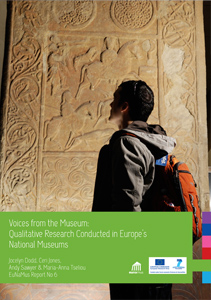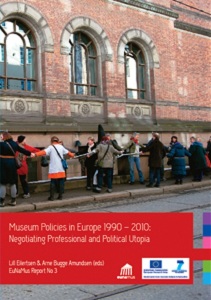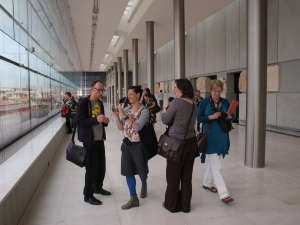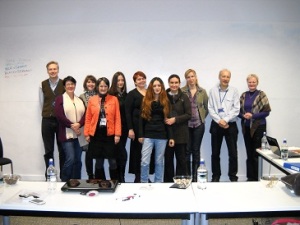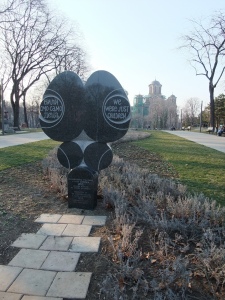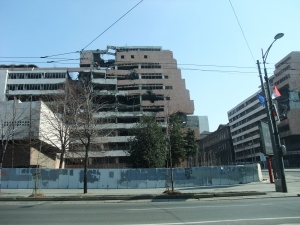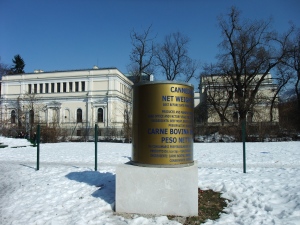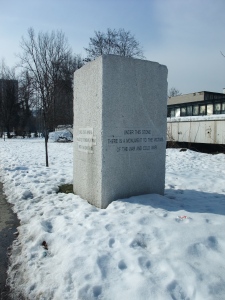By Bodil Axelsson
This post reports from the panels on Eunamus research and the creation of new history museums held at the Royal Museums of Art and History in Brussels, the Cinquantenaire Museum, the 25th of January. The panels were co-organised by Eunamus and the House of European History.
Museums have a role to play in the European unification. That was the message from Professor Chrysoula Paliadeli who in her role as a member of the European Parliament was invited to comment on the policy relevance of Eunamus research.

- Martin Schaerer, Chrysoula Paliadeli, Gabriella Elgenius,
- Dominique Poulot and Peter Aronsson
In his presentation, project coordinator Peter Aronsson pointed to the ways in which museums form a necessary part of a ‘cultural constitution’ supporting both a connective tissue of culture and underpinning the communicative spaces that are so crucial for democracy. Dominique Poulot emphasized how many national museums today strive to go beyond the national, to become agents of cultural diplomacy or to produce new representations of Europe in temporary exhibitions.
Picking up threads from both presentations, Chrysoula Paliadeli, stressed the importance of culture in times of economic crisis. She also raised concerns about national separatism and suggested that museums may support the European idea by collaborations, loans and exchanges. In his talk, Martin Schaerer from ICOM provided a bridge to the second panel: Entering the mine-fields – the creation of new history museums in Europe.
New history museums are on the top of the museum policy agenda in many countries in contemporary Europe. They are created by politicians, implemented by academics and made for the public. It seems to be a need for the reconstruction of identities that sparks these initiatives. It is not only conservative, or right wing, politicians who support them, rather opponents and proponents are found in several political camps, from left to right, and among both liberals and republicans.
How do then academics respond to the roles and tasks given them? The panellists seemed to agree upon the necessity of destabilizing simple and one-dimensional national identities by creating exhibitions that displays the ways in which national and European histories are constructed rather than given. The German case has proven successful, but time will tell how audiences will react to the other initiatives.

- Deutsches Historisches Museum
Rosmarie Beier-de Haan from the Deutsches Historisches Museum opened the discussions by highlighting how she and her colleagues had started with the question: who are the Germans today? Robert Kostro, from the National Museum for Polish History talked about how they are moulding a new narrative of freedom and democracy to support Polish identity. He also underlined that when handing over the task of creating a new museum to academics, politicians do not always get want they want.
Similarly, Charles Personnaz from The Maison de l’Histoire de France advocated the freedom of historians. This French initiative has sparked a sometimes fierce public debate on the possibility of producing a national history. What about the regions and the diversity of cultures within the contemporary state? Who are the French citizens and what is the role of history in the construction of a shared space for citizenry? In this situation, politicians may propose a museum, but they cannot dictate historical narratives.

- The future House of European History
The task given to Taja Vovk-van Gaal at the House of the European History, initiated by the European Parliament, is different. She coordinates academics from 18 countries and this museum is created in interactions between the staff. It is not about exhibiting a European mosaic of countries, but about displaying a reflexive European history, also including dark chapters such as colonialism and armed conflicts.
The public debates surrounding the House of European History concern the economic legitimacy of the initiative, rather than the content. This bias may be interpreted as a consequence of the current economic crisis, but it may also be interpreted as a lack of public interest in a common European history, perhaps also reflecting the need for a shared space to discuss cultural issues, and to enhance legitimacy for the European project.
The panels were moderated by Gabriella Elgenius, University of Oxford and Chantal Kesteloot, Centre for Historical Research and Documentation on War and Contemporary Society, Brussels.
There are plans to publish the talks later this year.
Programme
Read more on the event on the blog Une mine d’histoires / histoire de mines or in Swedish on the Museum nu blog
Eric Grubel delivered the speech prepared by Professor Michel Draguet, General Director a.i. of the Royal Museums of Art and History.
Alexandra Kalogirou replaced Xavier Troussard to represent the European Commission’s Directorate General Education and Culture.
Octavio Quintana Trias represented the European Commission’s Directorate General Research and Innovation.
Picture of the panelists: Andrew Sawyer, the Deutsches Historisches Museum: Peter Aronsson, and the future House of European History, Bodil Axelsson. Pictures below: Andrew Sawyer.

Peter Aronsson introduces Eunamus.

Felicity Bodenstein launches Eunamus wiki on heritage conflicts.


